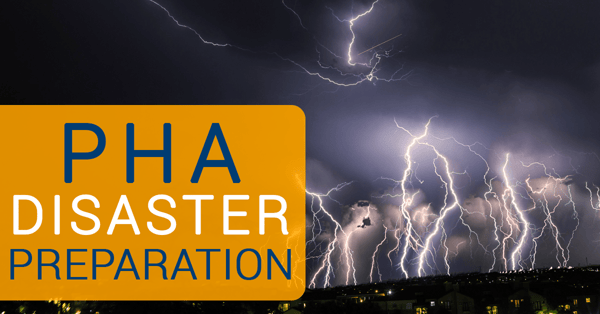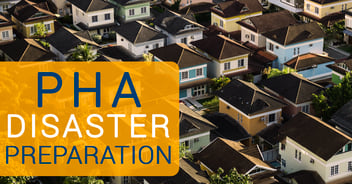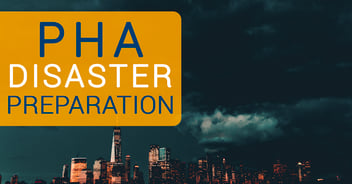How to prepare your PHA for potential disasters - Part 1

Disasters often strike unexpectedly and include a wide range of events. That’s why it’s important to be prepared before a disaster hits your community. By planning for disasters before they happen, you can help ensure your PHA has adequate resources and is ready to respond should a disaster affect your area. The information presented below aims to help your PHA create proper disaster plans and procedures as well as utilize all funding and resources that may be available during and after a disaster. This is a four part series, so be on the lookout for part two coming out next week!
Assessing your risks using a risk-based planning process
Where to start
When starting your disaster plan, certain assumptions should be made. They include, but are not limited to:
- A catastrophic incident or attack will occur with little or no warning
- There will be cascading effects associated with the incident
- Inter- and Intra-state, local, tribal, territorial, and insular area government mutual aid capabilities will be exhausted
- Local government capabilities may not exist or be functional
- Other federal agencies are executing relevant support under their own authorities
It is not likely that all these conditions will be true in a single event, but your preparation should consider all these a possibility. In doing so, you can ensure that your PHA has outlined what you will do if any of these assumptions become a reality.
The risk assessment
After creating your list of assumptions, a risk assessment should be conducted to help categorize potential events and the probability of each occurring. Risk assessments should aim to accomplish four main goals: identify hazards, profile hazards, inventory assets, and estimate losses.
When identifying hazards, it is highly important to plan based on your location, which should be a driving factor in your approach. Consideration should be given to the following:
- Proximity to the coast
- Potential for major weather events (winter snowstorms vs hurricanes or tornadoes)
- Proximity to biohazard plants
- Infrastructure vulnerabilities (levies, dams, flood control and drainage)
When profiling hazards, the focus should be on small events that might occur frequently, as well as massive regional or national events that are less likely to happen. This will help keep your PHA prepared for the more common issues that will occur and the potential of a rare or infrequent but more substantial occurrence.
When creating an inventory of assets, you should consider all buildings, material, machinery, and other such assets, doing so will help prepare you on everything that might have been lost during the disaster. Remember to account for smaller items including maintenance and janitorial supplies. Often times smaller equipment and supplies have significant cumulative value and cannot be reimbursed by insurance or disaster aid if not properly documented, inventoried, and tracked.
You will also need to estimate potential losses by considering and calculating what the expected losses will be for different events (as identified previously). This should be recorded so you’ll know ahead of time what costs you’ll be accruing during and after a disaster has occurs. Some of the resources available to PHAs include FEMA.gov, HUD’s CDBG-DR toolkit, and other local agencies.
Assessing vulnerabilities
Vulnerabilities can be difficult to identify, but every entity has unique vulnerabilities that are necessary to prepare for. Often times the impacts of a disaster are multiplied based on vulnerabilities that were apparent and known prior to the disaster occurring. When identifying vulnerabilities, you should review the natural environment, built environment, and barriers to accessing services.
When considering natural environments, you’ll need to look at location or proximity to hazard-prone areas. These areas are coasts, the tornado alley, floodplains, seismic zones, and potential contamination sites. You’ll need to determine which of these natural environments will have an impact on your community should a disaster occur. This will help you to determine what disaster plans you’ll need to make.
Built environments may include, but are not limited to, poorly constructed buildings, inadequately maintained public infrastructure, and inaccessible housing. Some public housing may be at greater risk because of age or health of residents which may require extra resources during and after a disaster. Another key factor to look at is the density of the buildings and/or residents who reside in them. Knowing the number of people located in an area can show you where you’ll need to spend extra time planning in your disaster preparation.
In addition to the natural and built environments, barriers to accessing services should also be considered. When assessing possible barriers, you’ll need to identify the services needed and their potential to be impacted by a disaster. Having this list will show you where you should allocate your resources, as well as creating a plan for these communities in case they are affected by a disaster.
Next: Continuity plans: how planning for the future impacts the present
About the author

With nearly a decade of experience in the affordable housing industry, James Karner has served with Nan McKay & Associates since 2012 in various roles including quality control, finance, procurement, compliance, and as a trainer. He is currently based in NMA’s Houston office, where he actively works on several CDBG-DR projects including Harris County, Texas and Joplin, Missouri.




